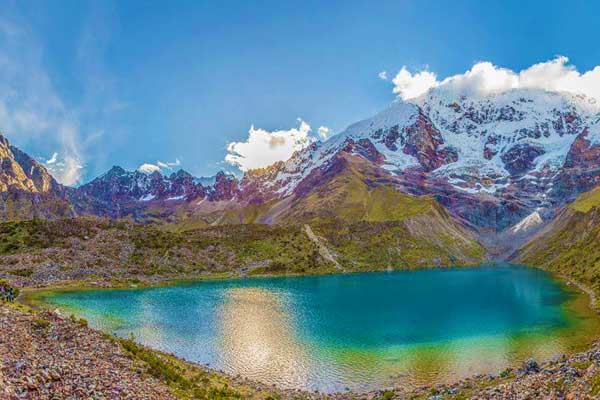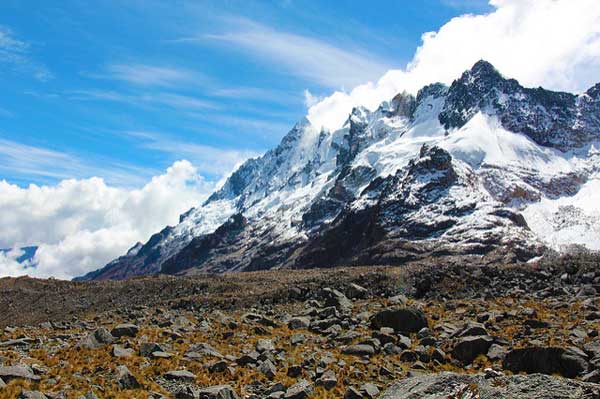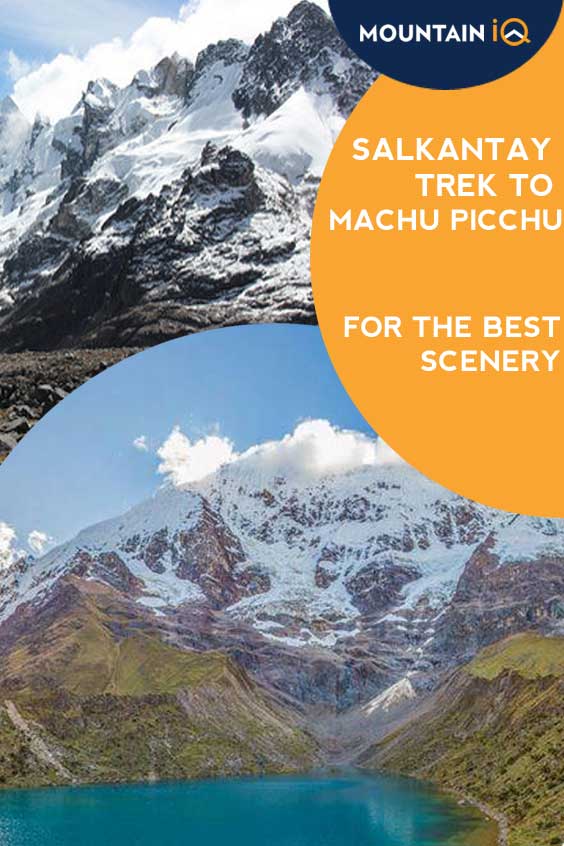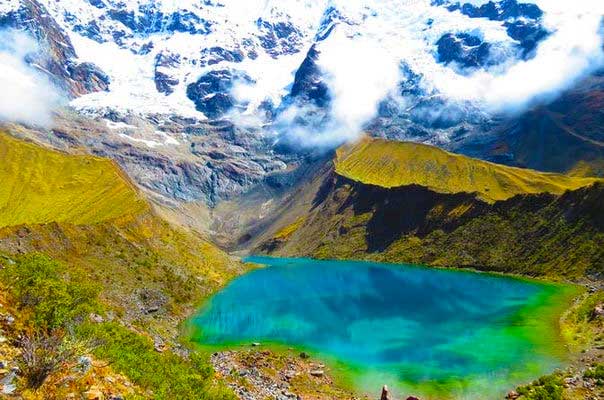Welcome to MountainIQ’s guide to hike The Salkantay - one of many great treks to Machu Picchu located in South America's picturesque mountain ranges.
Here you will find an overview of the Salkantay trail and learn about various options for a typical day-to-day itinerary, the best time of year to do the hike.
You will also find detailed information on what level of fitness is required for the hike, how to train, what to bring on the trek, and how much you should budget for a budget, mid-range or private Peruvian Andes adventure.
Salkantay Trail Overview
The Salkantay trek is the second most popular trek to Machu Picchu, after the Classic Inca Trail.
Some of the advantages of the trek are its accessibility from Cusco, the physically manageable climb and the diverse, impressive scenery the pathway passes on your way to Machu Picchu.
While most trekkers enjoy the help of a guide company, it is possible to complete this journey on your own. Guidelines for this more daring adventure are also detailed below.
There are several route variations that each add a different flavor to your experience.
Typically, the hike is concluded over a 5-day/ 4-night expedition. Although, it is possible to squeeze the mission into 4 days and 3 nights.
There is also the option of combining the Salkantay trail with the Classic Inca trail, which are outlined further below.
Mount Salkantay (or Nevada Salkantay/Salcantay), the mountain after which this trek is named, is one of the most iconic mountains in the area surrounding Cusco.
It stands at 6,271 m tall and the Quechua name Salkantay literally means savage or wild . Therefore, it is not conquered by any but the most intrepid mountaineers.
Although the Salkantay Trail fortunately doesn't entail summiting its breath-taking peak, trekkers will spend much of their hike with an impressive view of Mount Salkantay on approach and while scaling the Salkantay Pass.
The mountain is located 60km North-West of Cusco and is directly south of Machu Picchu.
Although invisible from the Citadel, Salkantay was auspiciously located and was believed to be one of the deities that determined the weather in the region.
Typical Salkantay Itinerary
Below is the most common 5-day/4-night itinerary used by most tour companies. Although slight variations on this standard itinerary is possible. We have also given extra information for those planning on trying the hike unassisted.
Day 1: Cusco to Salkantaypampa via Mollepata and Soraypampa
- Total distance: ~12 km
- Total time walking: ~ 5- 7 hours.
After an early morning departure from Cusco (3400m), you will drive for about 3 hours to the town of Mollepata for breakfast. If you are hiking without a tour company, you can either organize a private car or use the public bus for this drive.
Some may start the trek from Mollepata but the roads aren’t ideal and most tour operators skip these extra miles and transfer you on a 4 X4 to start from Sayapata (Sayllapata) (3200m).
From Sayapata, you start a gradual 3-to-4-hour climb towards Soraypampa (3850m), where you will probably stop for lunch. Some tour groups set up camp here, while others continue on to reach Salkantaypampa (3900m) in another 2-3 hours.
Day 2: Salkantaypampa to Collpapampa, via Soyrococha, Abra Salkantay and El Passo – Huaracmachay
- Total distance: ~15 km
- Total time walking: ~7-10 hours
Day 2 is going to be the most challenging of the Salkantay trek – so buckle up!
The trek from Salkantaypampa to Soyrococha (4470m) is about 2.5 hours long. The gradient slowly increases, and after about an hour you will reach the windy 7 Culebras (7 snakes), a zig-zagging pathway heading towards Soyrococha.
You will probably reach Soyrococha at around 10 am, and you will be feeling the effects of the high altitude by this point. But this is just the start of the challenge. After continuing upwards for about an hour you will reach Salkantay Pass (4600m) with amazing vistas of the mountain.
From here you will descend for 3 hours to Huaracmachay (3750m) where you will enjoy a well-deserved lunch. Some tour companies settle down here for the night, but most tours plan to continue for a 3-hour descent to Collpapampa (2850m) to end an impressive day.
Day 3: Collpapampa to La Playa
- Total distance: ~10 km
- Total time walking: ~6-7 hours
After a slight ascent in the early morning, your day will be spend walking down towards La Playa (2050m).
Day 3 might be a little more crowded with fellow trekkers than the previous days. If you are hiking alone it is a good idea for you to leave Collpapampa with another tour group to avoid getting confused by the subsidiary trails which lead off the main path which leads to La Playa.
La Playa is a small town, so many tour companies keep walking to Lacmabamba to avoid the bustle of locals and tourists.
Day 4: Colcamaya/La Playa - via Lucmabamba - Aguas Calientes
Option 1: Colcamaya to Aguas Calientes
Day 4 marks the end of the official hiking, but your adventure is not over yet. There are a number of options available to you to be discussed with your tour group beforehand.
If you are really exhausted from a long week of hiking, spending some time relaxing in the Hot Springs in Colcamaya near the town of Santa Theresa.
Here, you can spend the morning soaking your deserving feet, looking out at the scenic jungle. You will then be transported to Hidroelectrica Station from where you can either hike or catch a train to Aguas Calientes.
Option 2: La Playa to Aguas Calientes, via Lucmabamba
Another option for Day 4 is the most popular, means a quick early morning hike from La Playa to Lucmabamba. This option requires a up to 7 hours of trekking.
You will then spend about 2 hours hiking up to Llactapata, an Incan ruin discovered by Hiram Bingham on the same mission that Machu Picchu was discovered in 1911.
This site has not been restored as Machu Picchu has been, so it has the same overgrown appearance that Machu Picchu would have had if left to its own devices.
From here, you will catch your first glimpse of Machu Picchu itself. You will then hike down to the Hidroelectrica Station and catch the train or keep walking on to Aguas Calientes.
Finally, you have the option of riding South America’s highest zip-line which rests 150m off the ground in Cola de Mono. Hereafter, you either hike or train to Aguas Calientes.
Day 5: Machu Picchu
After rejuvenating overnight in a hotel in Aguas Calientes, you can take a bus up to Machu Picchu for a day of culture. We recommend heading up as early as possible to make the sunrise and avoid heavy crowds.
You can of course walk to Machu Picchu, but be prepared for a good 90-minute trek is ahead of you. Importantly, remember to bring your passport with you to enter Machu Picchu.
We also recommend either hiring a tour guide, or taking a good guide book alone because an informed walk around the ancient ruins improves the experience exponentially.
Some people also squeeze in a hike of Huayna Picchu, a mountain to the North of the citadel. This is amongst the craziest hikes in the world!
After your day in the Incan ruin, you can either walk or catch a bus back to Aguas Calientes, train to Ollantaytambo and finally train to Cusco.
If you’re hiking without a guide and are looking to cut costs, you can trek back to Hidroelectrica Station and bus all the way to Cusco via Santa Theresa and Ollantaytambo.

Photo by Tierras Vivas
Pro Tip: There is the added convenience that permits are not required to hike the Salkantay Trek as they are for the Inca Trail.
Salkantay / Inca Combo Itinerary
This trek has the beautiful scenery of the Salkantay Trail as well as the historical importance of the Classic Inca trail. The route is longer and tougher than the classic Salkantay Trail, taking 7 days and 6 nights as well as an Inca trail permit.
Day 1: Cusco to Ichupata via Mollepata and Soraypampa
After acclimatising in Cusco for at least 2-3 days, you’ll take a morning drive to Mollepata (3 hours) for breakfast and on for another 2 hours to Soraypampa. From Soraypampa you will hike for ~3 hours to Ichupata.
Day 2: Ichupata to Sisaypampa over the Incachiriasca Pass
Day 2 is tough, starting with a steep hike over the Incachiriasca Pass (4900m) and then a descent down to Sisaypampa (4100m) where you will likely spend the night.
Day 3: Sisaypampa to Ayapata
You will continue downwards to the small Pampacahuana community (3,300m).
You will then continue towards Paucarcancha, an Incan fortress, and then on to Wayllabamba where you will join the Classic Incan trail.
After lunch, you will head up from Wayllabamba towards Warmihuañusca Pass (aka Dead Woman’s Pass).
You will reach half way before setting up camp in Ayapata.
Day 4: Ayapata to Chaquicocha
The climb up Dead Woman’s Pass continues on Day 4, before the descent into Pacaymayo valley (3600m).
You will then traverse a second, easier pass called Abra Runkurakay (3,970m).
After passing the Runkurakay ruin, the Yanacocha Lake and the Sayacmarca ruin (3,624m) you will reach your campsite at Chaquicocha (3,600m).
Day 5: Chaquicocha to Wiñaywayna
Your fifth morning will begin with a climb up Abra de Phuyupatamarca Pass (3,700m).
After admiring the scenery and historical ruins, you will hike down to Wiñaywayna (2,650m) campsite for the night.
Day 6: Winaywayna – Machu Picchu
Day 6 is the typical “visit Machu Picchu day” and starts early in the morning to catch the sunrise.
You will generally trek to the Inti Punku (the Sun Gate) and thereafter experience a tour of the city, as explained above.

Photo by nonodelbosque
Best time to go on the Salkantay Trek
When deciding what time to hike the Salkantay trail, you must decide whether you want to prioritize good weather or relatively empty trails.
The dry months are generally between the end of April and the start of November.
While the Salkantay trek is never quite as busy as the Classic Inca trail, during the dry season some of the crowds do overflow from the Classic Inca trail to the second most popular alternative, the Salkantay Trek.
For this reason, we recommend hiking during the shoulder dry months of March/April and October/November to optimize the hiking conditions.
However, it is possible for you to enjoy you hike at almost all times of the year. Although we would strongly advise against going in the months of December, January and February when the rainfall is high.
The temperatures remain relatively constant throughout the year, with the average daily highs resting around 21°C and the night-time lows around 5°C.
It is common for temperatures to fall below freezing during the evenings though. So, you must be sure to be adequately prepared by packing layered clothing. See our packing list for advice on how to beat any bad weather.
If you decide to do a combined Salkantay-Machu Picchu trek, you can see more details about the best time of year to hike to Machu Picchu.
Salkantay Trail FAQ
Am I at risk from altitude sickness on the Salkantay Trail?
There is always the risk of getting altitude sickness on the Salkantay Trail. Its effects are felt by most at any point above 3,000m above sea level.
You will spend almost your entire trek to Machu Picchu above this point, reaching 4,600m (for the classic Salkantay Trek) or 4,900m (if you do the Salkantay/Inca combination).
Thus, you can expect to feel some degree of the symptoms with include fatigue, nausea and headaches.
It is impossible to predict your reaction to altitude sickness as it doesn’t have a correlation with your age or fitness level. So being wary of the effects and treatments is essential for a safe climb.
Some of the most important tips that will help in your efforts to avoid altitude sickness is to spend adequate time in Cusco (at least 2 days) or even some time in lower Sacred Valley.
It is important that you drink enough water – at least 2 liters per day, avoid drinking or taking drugs (including sleeping pills), and remember not to hike too fast.
What should I include in my Salkantay packing list?
There are a number of essential gear items that you might need to purchase to bring along on your Peruvian adventure along the Salkantay trail.
See more in our detailed Classic Inca Trail packing list as you'll need the same hiking equipment for the Salkantay trail too.

Do I need to do any training for the Salkantary Trek?
You definitely need some training for the Salkantay Trek. The Salkantay and Inca/Salkantay Combo treks are both considered moderate to challenging (particularly the latter).
To ensure that you are in the best possible condition to undertake this adventure, you must be relatively aerobically fit, training about 3 times a week in the gym in the months leading up to your hike.
Exercises like cycling, running and swimming will be great to get your cardiovascular fitness up.
It is also a good idea to go on a few day-long hikes in your own country to harden your muscles, break in your boots and give you a feel for what you should be expecting.
How much does the Salkantay Trek cost?
The cost of your Salkantay trek varies hugely depending on the quality of experience and touring company you choose.
You can of course undertake to do the trek alone, but this is not advisable to for an inexperienced trekker. Otherwise, there are tours which cost as low as $450 per person, all the way up to $1,300 per person.
See more details in our article on Machu Picchu trekking costs.
Do you recommended reading any guidebooks before hiking the Salkantay?
It never hurts to do some light reading on the region you're about to travel to. The Lonely Planet Peru Travel Guide is one of the most detailed, yet easy to digest guidebooks on the Peruvian Andes and has most of the Salkantay treks and routes in it.
Other Hiking Articles:


